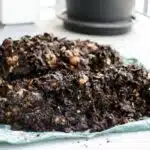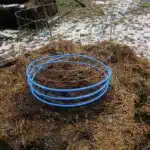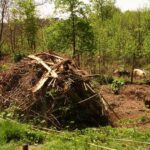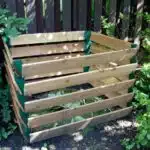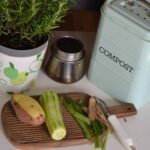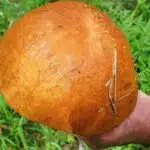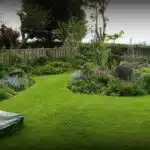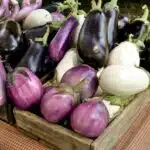If you’ve been looking for a way to reduce your carbon footprint, then the answer is simple: start composting now! Sure, the idea of making a compost pile may sound intimidating, but believe it or not, it’s actually quite easy. In fact, with just a few basic supplies and some minimal effort, you can turn your kitchen scraps into nutrient-rich soil for your garden in no time!
So what are you waiting for? Let’s get started on this journey of becoming an eco-friendly composter! We’ll cover the basics of what materials you need, how to set up your compost pile, and the best practices for feeding and maintaining it so that you can start helping the environment — one scrap at a time.
Ready to become an earth-saving composter? Then let’s dive in and learn about how to make a compost pile – the best way to start composting!
Benefits Of Composting
Have you ever thought about all the benefits of composting? Well, it’s time to get on board with this eco-friendly trend! With composting, you can reduce your waste, create a healthier environment and even help your wallet. It’s a win-win situation! But, before you jump into the world of composting, let’s take a look at how to start.
Composting is the process of breaking down organic matter (such as food scraps and yard trimmings) into nutrient-rich soil. This nutrient-rich soil can then be used in gardens or flower beds to improve plant health. Starting a compost pile is easy and can be done with just a few simple steps.
First, decide where your compost pile will go. Your location should be close to your garden for easy access but far enough away from your house for odor control. You’ll also want to make sure it’s a safe spot that won’t attract pests or animals looking for food. Next, purchase a bin or container for the compost pile and fill it with organic matter such as vegetable scraps, coffee grounds and grass clippings. Finally, add water regularly and turn the pile every week to keep air flowing through it and promote decomposition. Once your compost pile is up and running, you’ll need to know what items can be added in order to maximize its efficiency…
What Can Be Composted
Composting is a great way to reduce waste while also providing nutrient-rich soil for your garden. But before you start, it’s important to know what can be composted.
Organic materials like food scraps, lawn clippings, and leaves are ideal candidates for compost. You can even add things like shredded newspaper, cardboard, and paper towels to the pile. However, it’s important to avoid adding anything that might contain pesticides or chemicals as this could harm your garden in the long run.
Some materials should never be added to a compost pile as they can attract pests or contain harmful bacteria that can contaminate other items in the pile. These include meat, dairy products, fats and oils, pet waste, diseased plants, and weeds with mature seeds. By avoiding these items from entering your compost pile you’ll end up with a high quality organic fertilizer for your garden.
Now that you know what can go into your compost pile it’s time to choose a location for it.
Choosing A Location
Choosing a location for your compost pile is an important step when starting to compost. The area should be easily accessible and have adequate drainage. You’ll also want to make sure the spot isn’t in direct sunlight, or else your compost may get too hot and dry out. It’s also best to avoid keeping it near trees or shrubs, as they can compete with your pile for moisture and nutrients.
If you’re limited in space, there are options available that won’t take up too much room. Composting bins come in various sizes and types, ranging from small countertop bins to large outdoor bins. Most outdoor bins have lids that keep critters out of your pile and provide extra insulation during cold months. Additionally, you can buy special containers that are designed to fit into tight spaces like balconies or courtyards.
Whether you choose a bin or a traditional open-air pile, be sure to select a spot that will allow for easy turning of the compost material (usually every 1-3 weeks). This helps the materials break down faster and ensures that you get finished compost sooner rather than later. With the right location chosen, it’s time to start building your compost pile!
Building A Compost Pile
Composting is an increasingly popular way of reusing food and garden waste. According to a survey from the Environmental Protection Agency, over 90% of Americans are now actively composting or interested in doing so. Building a compost pile is an essential part of the process.
The first step to building your compost pile is to choose the right location. This should be a dry, shady area away from direct sunlight and close enough to your home that it’s easy to access. Once you’ve chosen your location, it’s time to start building!
The size and shape of your compost pile will depend on the amount of material you’re dealing with, but in general it should be at least three feet high and wide. You can use bricks, wood pallets or chicken wire to create walls around your compost pile. This will help keep it together while allowing air and moisture to reach the inside. If you have larger pieces of material, like branches or twigs, break them up into smaller pieces before adding them to your pile as these take longer to decompose. It’s also important to mix different types of organic materials together for better results. This includes adding green matter like kitchen scraps along with brown matter such as dried grass clippings and leaves. Once you have all the materials ready, layer them in alternating layers until you’ve built up your compost pile about three feet high. With these steps completed, you’re now ready for the final stage: selecting the right materials for composting!
Choosing The Right Materials For Composting
Choosing the right materials for composting is an important part of the composting process. Organic matter such as food scraps, coffee grounds, and yard waste can be added to a compost pile. However, it’s important to avoid adding certain items like meat, dairy products, oils, or pet waste. These materials can cause odors and attract pests. The best way to ensure success when composting is to create a balanced mix of green and brown materials.
Green materials are high in nitrogen and include grass clippings, fresh leaves, vegetable scraps, and fruit peels. Brown materials are high in carbon and include straw, dried leaves, cardboard rolls, eggshells, and newspaper. When combined in the right ratio, these materials provide the necessary oxygen and moisture needed for microbes to break down organic matter into nutrient-rich soil.
Adding a layer of soil or finished compost every few inches will help introduce beneficial bacteria into the pile which will aid in decomposition. It’s also important to keep an eye on the moisture level of the pile; too much or too little water can slow down decomposition rates significantly. With these tips in mind and a little practice, you’ll be well on your way to making nutrient-rich compost for your garden! Next up is temperature maintenance – how warm does your compost need to get?
Temperature Maintenance
Have you ever wondered how to keep your compost pile at the right temperature? Proper temperature maintenance is key to keeping your compost pile healthy. Let’s take a look at how it’s done.
The ideal temperature range for a compost pile is between 120-150 degrees Fahrenheit. To measure the temperature of your compost, use a thermometer and insert it into the center of your pile. After taking several readings, you can then adjust the moisture or aeration levels of your pile. You’ll want to make sure that you don’t let the temperature drop below 90 degrees, as this could cause anaerobic bacteria to grow in your pile and create odors.
To keep the temperature up, regularly turn over the compost with a pitchfork or shovel and add more materials such as manure, shredded newspaper, or garden clippings. This will also help introduce oxygen into the mix which is necessary for decomposition and microbial activity that helps break down organic matter quickly. If you find that your compost is still not heating up enough, consider adding an extra layer of soil on top which can help retain heat better while still allowing air flow through the pile.
Now we have a good idea of how to maintain our compost piles’ temperatures – next let’s look at moisture maintenance!
Moisture Maintenance
Maintaining the moisture level of a compost pile is essential to achieve its full potential in terms of nutrient production and decomposition. Too much moisture can create anaerobic conditions, resulting in the proliferation of odor-causing bacteria and other microorganisms, while too little will slow down or prevent the breakdown of organic matter. To ensure optimal moisture levels, it’s important to cover the pile with a tarp or sheet to keep rainwater out and occasionally mist it with a garden hose as necessary.
It’s also important to pay attention to drainage in your compost pile. If you notice any standing water or areas that appear overly soggy, you’ll want to mix in some additional dry material like straw or shredded paper. This will help absorb excess moisture and encourage air flow throughout the pile, which is necessary for aerobic decomposition.
Finally, it’s important to monitor your compost pile regularly for signs of excessive moisture. Check periodically for musty odors or any pools of liquid that may have formed on top of it. If either are present, add some dry materials and mix them into the pile using a pitchfork or shovel. With careful monitoring and adjustments as needed, you can maintain optimal moisture levels in your compost pile for maximum decomposition efficiency. Ready to move onto aeration considerations?
Aeration Considerations
Aeration is a key factor in a successful compost pile. Without aeration, the pile will not be able to break down the materials and create compost. To ensure proper aeration, you’ll need to periodically turn the pile with a shovel or pitchfork. This helps to mix up the materials and add oxygen for decomposition.
It’s important to note that you should never compact your compost pile; this will prevent air from flow through and could lead to anaerobic conditions, which will cause odors instead of compost. You should also avoid adding too much material to your compost pile at once as this can inhibit air flow and slow down decomposition.
To keep your compost pile healthy, it’s best to add small layers of material at a time and turn the pile every couple of weeks. This will help ensure that your compost has enough oxygen and moisture for decomposition. With proper aeration, you can create quality compost in no time!
Turning The Compost Pile
Starting up a compost pile is an exciting endeavor, but it’s important to remember that the process takes time and effort. Turning the compost pile is one of the essential steps in creating a healthy and productive compost system.
Every few weeks, it’s important to turn the compost pile to ensure that all parts of it are getting enough oxygen. This helps to speed up the decomposition process and prevents diseases from forming in any food scraps or other items in the pile. To turn the pile, use a shovel to mix up all of its contents – this not only adds air but also helps distribute moisture evenly throughout which further aids in decomposition.
In addition, turning your compost pile can help control odors and pesky pests, as well as other animals or bugs that may be attracted by decomposing materials. When turning your compost pile regularly and keeping an eye on potential problems, you’ll be able to ensure that you’re producing healthy and nutrient-rich soil for your garden!
Controlling Odors And Pests
Controlling odors and pests in a compost pile is like a balancing act – too much of one, and the other will suffer. Fortunately, there are some steps that can be taken to keep both odors and pests in check without compromising the health of the compost pile.
One way to reduce odors is to mix dry materials such as leaves, twigs, and shredded paper with wet materials like fruit and vegetable scraps. This helps to absorb any excess moisture while providing an environment that’s less appealing to pests. Additionally, adding a layer of soil or compost on top of the pile can help suppress smells and discourage animals from digging in.
To control pests, it’s important to use ingredients that are high in nitrogen like grass clippings or coffee grounds for a healthy balance. Keeping the compost moist but not too wet also discourages pests from entering the pile. Lastly, ensuring there is plenty of aeration by turning the compost every so often helps create an environment where organisms essential for breakdown thrive instead of unwanted critters.
By following these steps, you can keep your compost heap healthy while avoiding unpleasant odors and unwelcome guests.
Composting Troubleshooting
Composting is an essential part of gardening and a great way to reduce waste. But, it can be tricky when you’re just starting out. That’s why troubleshooting common composting issues is the key to success.
First, if you’re having problems with odor, it’s likely that you need to adjust the ratio of wet and dry materials in your compost pile. Aim for a mix of two parts brown materials (like leaves or branches) to one part green materials (like grass clippings or vegetable scraps). This will ensure your pile doesn’t get too wet or smelly.
Second, pests can also be a problem when composting. To keep critters away from your compost pile, make sure the materials are fully covered with soil or mulch so they can’t smell it from afar. Additionally, try adding some herbs like rosemary or lavender as a natural pest repellent!
Finally, don’t forget that aeration is important for healthy composting. To increase airflow and oxygen levels in the pile, turn it regularly with a garden fork or spade and make sure there aren’t any large chunks of material blocking air flow. With these tips in mind, you’ll be well on your way to creating the perfect compost pile!
Harvesting The Compost
Harvesting the compost is the final step in making a successful compost pile. While it may seem daunting, it is in fact easy to do and will reward you with nutrient-rich soil for your garden or house plants. But before we get into harvesting, let’s take a look at the theory behind why composting works. Composting is a natural process that breaks down organic materials over time; this creates an ideal environment for beneficial microorganisms to thrive and in turn produces rich, fertile soil.
The process of harvesting your compost can be done in two ways: either by sifting or by hand. Sifting requires the use of a sieve, which separates the larger pieces of material from the smaller ones; this ensures that you’ll have more uniformity when applying it to your garden or potting soil. Hand harvesting involves taking out individual clumps of compost and then breaking them down further into smaller pieces; this allows you to spread it more evenly over your soil.
Whichever method you choose, make sure to wear protective gloves and keep an eye out for any small stones or other debris that might have made its way into your pile. After you’ve harvested all the compost, store it in a cool and dry place until you’re ready to use it—this will help preserve its nutrients for longer periods of time. With all these steps taken care of, you can now move on to using your fresh batch of compost!
Using The Compost
It’s time to reap the rewards of your hard work – it’s time to use the compost! The fruits of your labor are ready to be enjoyed, and now you can learn how to make the most out of your compost pile. So, let’s dive right in and explore all things composting – past, present, and future.
First off, you’ll want to decide how you’d like to use the compost. You’ve got a few options here: as a fertilizer for houseplants, as a soil amendment for outdoor plants, or simply as an effective way to reduce waste. Whichever route you choose, using your compost is sure to be beneficial for both you and the environment.
But before you get started using your compost, there are some important safety precautions that should be taken into consideration. For example, if you’re using the compost on edible crops or vegetables, it’s essential that the compost has been well-aged so that any harmful bacteria have had enough time to break down. Additionally, avoid consuming raw compost – no matter how tempting! And don’t forget protective gear such as gloves when handling compost as it could contain sharp objects or irritants.
Now that we’ve gone over some of our tips on safely using the compost pile, let’s look at some resources for further information…
Resources For Further Information
While composting has become increasingly popular in recent years, with some estimates suggesting that up to 20% of households now compost their food waste, understanding the best way to start can be daunting. This current H2 provides resources for further information about creating a successful compost pile.
First and foremost, it’s important to understand the basics of what should be included in your compost pile. Manure, grass clippings, leaves, garden waste and kitchen scraps are all items which can make an excellent addition if they meet the right criteria. It is also worth researching local regulations regarding acceptable materials for compost piles as some areas may have restrictions on what can and cannot be used.
In addition to these basics, there are a number of other helpful resources available online which provide additional advice and tips on successfully setting up a compost pile. Websites such as Green Living Tips and Compost Guide offer detailed explanations on how to create an effective compost pile and provide useful advice on maintaining it throughout its lifespan. Furthermore, many local councils also offer free or discounted material for use in home composting projects which is well worth taking advantage of.
With these resources at hand, anyone can learn how to start a successful compost pile. Armed with this knowledge, it will hopefully be easier than ever before to get started with creating your own nutrient-rich soil amendment!
Tips For Successful Composting
Composting is an effortless way to reduce waste and create nutrient-rich soil for growing. However, it’s not always easy to get started if you don’t know the tips and tricks of successful composting. To help, here are a few pointers that will have your compost pile flourishing in no time.
To illustrate, imagine a garden as a living organism with many different parts all working together towards a common goal – producing lush greenery and delicious veggies. Composting plays an essential role in this cycle, providing the rich minerals needed for healthy soil. With the right steps, you can create your own compost pile and watch your garden flourish.
Start by gathering organic materials like vegetable scraps and leaves from the yard. It’s important to mix them evenly into alternating layers of nitrogen-rich greens and carbon-rich browns for optimal decomposition. Make sure to regularly turn over the pile using a shovel or pitchfork so oxygen can flow through it and hasten the process of decay. Additionally, consider adding moisture as needed with water or rainwater to reach an ideal moisture level for decomposing material quickly.
Once you’ve got your compost pile set up, it won’t be long before you’ll be able to reap the benefits of its nutrient-rich soil! With these tips in mind, you’ll have success creating a sustainable compost system in no time at all.
Frequently Asked Questions
How Often Should I Turn The Compost Pile?
Tending to a compost pile can be a rewarding experience – the satisfaction of nurturing something and watching it grow! But how often should you turn your compost pile? This is an important question to consider when learning how to make a compost pile, and there are some key points you should keep in mind.
Turning your compost pile is essential for aerating the material and helping it break down. It’s recommended that you turn your pile with a pitchfork or shovel every two weeks during the warmer months of summer. Doing this will ensure that the organic matter gets enough oxygen and breaks down into rich soil more quickly. During colder months, turning it once a month should suffice.
It’s also important to mix your newly added material with older material for best results – this ensures everything breaks down at the same rate. And don’t forget to check moisture levels – if your compost is too dry, give it a sprinkle of water; if it’s too wet, add more dry material like leaves or shredded paper. With these tips, you’ll have beautiful compost in no time!
How Long Does It Take For Compost To Be Ready To Use?
Composting is a great way to reduce waste and create a nutrient-rich soil amendment for your garden. But one of the key questions when it comes to composting is how long does it take for the compost to be ready for use?
The timeline for compost can vary depending on the size of the pile and the type of material that’s used in it. A smaller, properly managed pile should be ready within four to six months, while larger piles may take up to a year or more. Generally speaking, it takes patience and consistency to get good results from your compost pile.
Managing your pile by turning it regularly and ensuring that there’s enough moisture will help speed up the process. Keeping an eye on the temperature of your compost is also important – if it gets too hot, you may need to add more carbon-rich material like dead leaves or shredded cardboard. With proper management and patience, you’ll have rich, dark compost that’s ideal for adding fertility to your garden beds in no time!
Does Composting Attract Animals Or Pests?
As composting gains popularity as an eco-friendly way to reduce waste, it raises the question of whether composting can attract unwanted visitors. Compost piles bring together a mix of organic materials that, when left to decompose, release an aroma that may draw in some animals and pests.
To understand if composting attracts wildlife or pests, we first need to take a look at what goes into a compost pile. It’s typically made up of kitchen scraps such as vegetable and fruit peels, coffee grounds and tea leaves, as well as yard waste like grass clippings and fallen leaves. These items are layered with soil and moistened with water to create a rich mixture of nutrients which will eventually break down into nutrient-rich fertilizer that can be used in gardens or lawns.
The scent of decomposing organic matter is sure to be a temptation for some animals looking for an easy meal. In addition, too much moisture in the pile can invite insects seeking out water or food sources. The best way to avoid attracting pests is by properly managing your compost pile; keep the pile moist but not wet, turn it regularly and make sure animal waste doesn’t find its way into the mix. Following these steps will help ensure that your compost pile remains neat and tidy without any uninvited guests.
Compost piles are great for reducing household waste but with their inviting smells they also present potential problems with animals and pests invading the area. To prevent this from happening it’s important to stay on top of regular maintenance while remaining aware of what goes into your compost pile so you don’t end up with any unwelcome visitors during the process.
What Type Of Container Should I Use For Composting?
Composting is a great way to reduce your environmental footprint and to contribute to the health of your garden. But, it’s important to do it correctly. One of the key questions for composters is: what kind of container should I use?
When it comes to selecting a container for your compost pile, there are plenty of options available. From plastic bins and bags to wooden pallets and metal drums, you can find something that suits your needs. But how do you choose the best option?
On one hand, plastic containers are lightweight and easy to move around, making them convenient for busy gardeners who need to access their compost quickly. On the other hand, wooden pallets provide more stability and a better overall appearance. And if you’re looking for something even more attractive or sturdy, metal drums can be an excellent choice. Each has its own benefits and drawbacks – so consider all of them before deciding which one is right for you!
No matter which container you choose, make sure that it’s well-ventilated to ensure optimal composting conditions. With proper care and attention, your compost pile will be up and running in no time!
Can I Compost Kitchen Scraps And Yard Waste Together?
A staggering 50% of all household waste in the United States is made up of compostable material, making composting an excellent way to reduce our impact on the environment. Can kitchen scraps and yard waste be composted together? The answer is yes! Composting these items together can help create a nutrient-rich soil amendment that can be used for gardening and landscaping purposes.
When deciding what to compost, it’s important to consider the ratio of carbon-rich material (such as leaves, straw, sawdust, and wood chips) to nitrogen-rich material (such as food scraps, grass clippings, coffee grounds, and manure). The ideal ratio is two parts carbon-rich material to one part nitrogen-rich material. This will ensure a healthy balance between the two materials.
To start composting kitchen scraps and yard waste together, you should first layer your bin with alternating layers of carbon-rich and nitrogen-rich materials. Then add some water and mix it into the pile until it’s damp but not soggy. Finally, add some compost starter or soil microbes to help kickstart the decomposition process. With proper care and maintenance, you’ll have nutrient-dense compost ready in no time!
Conclusion
Composting is a great way to reduce waste and create a nutrient-rich soil to use in your garden. It’s an easy process that doesn’t require much effort, but it does take some time and patience. Turning the compost pile regularly helps speed up the decomposition process and ensures that all the materials are evenly broken down.
It’s important to remember that different materials will break down at different rates, so you may need to wait several months before your compost is ready for use. Additionally, composting can attract animals or pests, so make sure to keep the compost pile away from your home or any other high traffic areas.
Overall, composting is an excellent way to both reduce waste and give back to your garden. While it takes some patience and effort, the end result is worth it—a nutrient-rich soil that can help produce healthy plants and vegetables! As one gardener put it: “Composting has been like adding a secret ingredient to my plant babies’ diets – like giving them an extra dose of vitamins!” “It’s like my plants are getting a super-boost of health and vitality.


